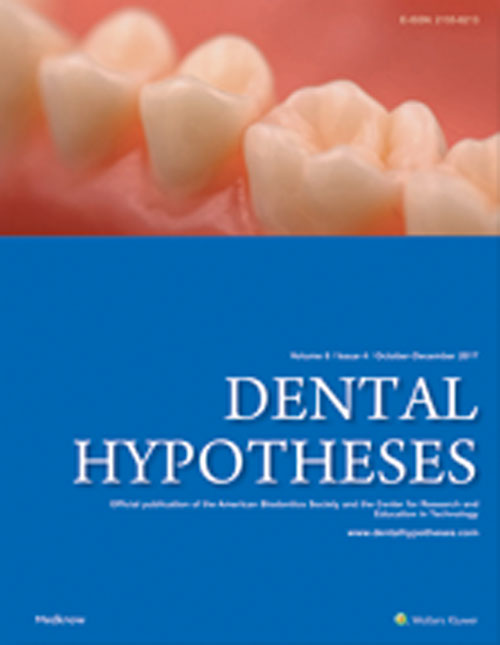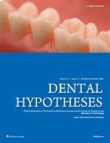فهرست مطالب

Dental Hypotheses
Volume:10 Issue: 1, Jan-Mar 2019
- تاریخ انتشار: 1397/12/11
- تعداد عناوین: 5
-
Pages 4-8IntroductionMineral trioxide aggregate (MTA) and other calcium silicate cement similar to that are widely used in endodontic treatments. One of the widely emphasized disadvantages of these cements are the induction of tooth discoloration. The purpose of this study was to investigate the mechanisms of tooth discoloration caused by MTA and MTA-like cements and debate different methods suggested for preventing it.MethodsAn electronic search was performed using databases such as Google Scholar, PubMed, PubMed Central, Science Direct, and Scopus by using keywords such as “mineral trioxide aggregate”, “calcium-silicate”, “tooth discoloration”, and “prevention”.ResultsSeveral methods for preventing tooth discoloration caused by MTA and MTA-like cements have been proposed including the application of dentin bonding agents on dentinal walls, use of cements containing radiopacifying agents other than bismuth oxide, and addition of zinc oxide to those cements containing bismuth oxide.ConclusionMost studies have shown that none of these methods can completely inhibit tooth discoloration but can decrease it to some length.Keywords: Calcium silicate cement, discoloration, mineral trioxide aggregate, prevention
-
Pages 9-13IntroductionWhich were weakening furcation area can reduce tooth strength again stfracture.The present study assessed fractureresistance in the mandibular first molars perforated at furcation area and sealed with mineral trioxide aggregate (MTA). This study was aimed to investigate the effect of furcationper foration size on fractureresistance in first mandibularmolar teeth.Materialand MethodsThecervical region of 50 mandibular first molars were cut at cenentum enamel junction level. After root preparation and obturation, the samples were randomly classified into five groups :group1:1mm perforation ,reconstructed with MTA ;group2:1mm perforation, withoutrepair,withwax filling; group 3:2mm perforation, reconstructed with MTA; group 4:2mm perforation, without repair, with wax filling; and group 5: without perforation. The compressive force breaking each sample was recorded. Data were subjected to SPSS-20 software to analyze by Kolmogorov–Smirnov test, two-way ANOVA, and independent samples t-test.ResultsFurcation perforation and MTA had no significant effect on the force at the break point; no significant difference between 1 and 2mm perforations either MTA restored or wax filled was registered. Nosignificant difference in mean force at the break point between groups with or without perforation was observed.ConclusionsOne and 2mm furcation perforation does not reduce the fracturer esistance. MTAin1or 2 mm perforations does not increase the fracture resistance.Keywords: Furcation perforation, fracture resistance, MTA
-
Pages 14-19IntroductionAberrant root canal morphology of mandibular premolars has always been associated with high endodontic treatment failures. This study was conducted to assess the canal morphology of the mandibular premolars in the Malaysian population using periapical radiographs and cross-sections of the premolar teeth.Materials and MethodsOne hundred extracted permanent mandibular premolars with intact apex were randomly collected from various clinics across Malaysia. Radiographs were taken both in mesiodistal (MD) and buccolingual (BL) views to examine the presence of a second canal and to evaluate the type of canal configuration. The roots were then stained and perpendicularly resected to the long axis at three levels (cervical, middle, and apical one third). Digital photographs were taken for each of the cross-section sample and analyzed according to the number and shape of canals.ResultsIt was found that 78% of the mandibular premolars had single canal in BL radiographic view and 65% in MD view. Seventy-one percent of the single-canal premolars were observed in all three cross-sectional views (1-1-1 configuration). Furthermore, 37% showed oval-shaped canals and 34% showed irregular-shaped canals mainly found at cervical one third; 20% of the teeth showed the canals to be rounded in shape, most prevalent at the apical one third. Two canals with isthmus were observed in 5% of the all cross-sectional views.ConclusionThe majority of mandibular premolars in Malaysian population have a single canal, and there are a few possibilities of two or more canals in these teeth.Keywords: Endodontics, mandibular premolars, radiography, root canal, tooth morphology
-
Pages 20-24IntroductionImpression technique plays apivotal role infixed prosthodontic treatments; one of the main steps of impression is selection and preparation of an appropriate tray. Impression technique with insufficient accuracy causes distortions and complications that consequently result in treatment failure. The present study compares the impression accuracy of special and prefabricated trays in a laboratory model. This article compares the accuracy of special and prefabricated impression trays for achieving better impression and finally better crowns with good adaptation.Materials and MethodsIn this study, a laboratory-fabricated resin model, resembling a mandibular first molar, was used on a dental arch and prepared by standard method for full crown restorations with a finish line of 1-mm depth and 3° to 4° convergence angle. Impression was made from a laboratory-fabricated resin model, 40 times with monophase medium-body polyvinyl siloxane in special trays and 40 times with putty and light-body polyvinyl siloxane using double-mix impression technique without spacer in prefabricated trays. To measure margin algap,distance between the restoration margin and preparation finish line was vertically determine done achdiein the mesial, distal,buccal,andlingualregions.Statistical analysis was performed and data were analyzed by SPSS20 software using independentsamples t-test. The data were significantly different at P < 0.05.ResultsThe mean value of special tray impression (72.72) was lower than that of prefabricated tray impression (91.27). No significant difference was observed between two techniques in the mesial and buccal regions (P > 0.05). However, a significant difference wasreported between the techniques in the lingual and distal regions.ConclusionThe present study indicated a higher accuracy for the special tray impression than prefabricated tray impression.Keywords: Additional silicone, impression, prefabricated tray, special tray


